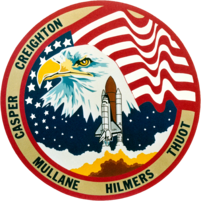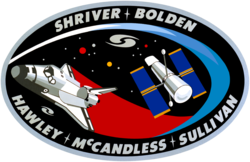STS-36
| Missionsemblem | |||||
|---|---|---|---|---|---|
 | |||||
| Missionsstatistik | |||||
| Missionsnavn: | STS-36 | ||||
| Rumagentur: | NASA | ||||
| Rumfærge: | Atlantis (6) | ||||
| Antal besætningsmedlemmer: | 5 | ||||
| Affyringsrampe: | LC-39A (KSC) | ||||
| Opsendelse: | 28 februar 1990 | ||||
| Landing: | 4 marts 1990 | ||||
| Landet på: | Edwards Air Force Base | ||||
| Varighed: | 4 døgn og 10 timer | ||||
| Foto af besætningen | |||||
 | |||||
| Navigation | |||||
| |||||
STS-36 (Space Transportation System-36) var rumfærgen Atlantis 6. rumfærge-mission. Den blev opsendt d. 28. februar 1990 og vendte tilbage den 4. marts 1990.
Missionen medbragte klassificeret militær last for Forsvarsministeriet (USA) (DoD).
Hovedartikler:
Besætning

 John Creighton (kaptajn)
John Creighton (kaptajn)
 John Casper (pilot)
John Casper (pilot)
 Richard Mullane (1. missionsspecialist)
Richard Mullane (1. missionsspecialist)
 David Hilmers (2. missionsspecialist)
David Hilmers (2. missionsspecialist)
 Pierre Thuot (3. missionsspecialist)
Pierre Thuot (3. missionsspecialist)
Missionen
Missionen medbragte følgende nyttelast:
- Hemmelig militær last.
- KH-11-10/KENNAN (USA-53) spionsatellit, blev også kaldt Misty [1][2].
En af astronauterne blev syg under flyvningen for første gang siden Apollo 13.
Eksterne henvisninger
- STS-36 NASA (engelsk)
- STS-36 Arkiveret 27. maj 2010 hos Wayback Machine NASA KSC (engelsk)
- ^ NSSDC ID: 1990-019B NASA
- ^ MISTY / AFP-731 Arkiveret 4. juli 2008 hos Wayback Machine Military Space Programs / FAS
| ||||||||
Medier brugt på denne side
STS-32 Mission Insignia
- The STS-32 patch, designed by the five crewmembers for the January, 1990 space mission, depicts the Space Shuttle orbiter rendezvousing with the Long Duration Exposure Facility (LDEF) satellite from above and the Syncom satellite successfully deployed and on its way to geosynchronous orbit. Five stars represent the mission number with three on one side of the orbiter and two on the other. The seven major rays of the sun are in remembrance of the crewmembers for STS 51-L. In preparation for the first Extended Duration Orbiter (EDO) missions, STS-32 conducted a number of medical and middeck scientific experiments. The caduceus on the left represents the medical experiments, and the crystalline structure on the right represents the materials science. The crew is comprised of Astronauts Daniel C. Brandenstein, James D. Wetherbee, Bonnie Dunbar, Marsha S. Ivins, and G. David Low.
Space Shuttle Atlantis takes flight on its STS-27 mission on December 2, 1988, 9:30 a.m. EST, utilizing 375,000 pounds thrust produced by its three main engines. The STS-27 was the third classified mission dedicated to the Department of Defense (DoD). After completion of mission, Orbiter Atlantis landed December 6, 1988, 3:36 p.m. PST at Edwards Air Force Base, California.
STS-36 Mission Insignia
The STS-36 crew portrait features 5 astronauts who served in the 6th Department of Defense (DOD) mission. Posed near the Space Shuttle Orbiter Discovery are (left to right) Pierre J. Thuot, mission specialist 3; John H. Caster, pilot; John H. Creighton, commander; Richard M. (Mike) Mullane, mission specialist 1; and David. C. Hilmers, mission specialist 2. The crew launched aboard Atlantis on February 28, 1990 at 2:50:22am (EST).
STS-31 shuttle mission flight insignia. The mission insignia for NASA's STS-31 mission features the Hubble Space Telescope (HST) in its observing configuration against a background of the universe it will study. The cosmos includes a stylistic depiction of galaxies in recognition of the contribution made by Sir Edwin Hubble to our understanding of the nature of galaxies and the expansion of the universe. The STS-31 crew points out that is it in honor of Hubble's work that this great observatory in space bears his name. The depicted Space Shuttle trails a spectrum symbolic of both the red shift observations that were so important to Hubble's work and new information which will be obtained with the HST. Encircling the art work, designed by the crew, are the names of its members.
Forfatter/Opretter: Kwamikagami, Licens: CC BY-SA 4.0
symbol of Mars. 16 × 16 pixel nominal dimensions, lines 2 pixel thick, square caps. Colour 75% blue: red=0 green=0 blue=191 (#0000BF).







